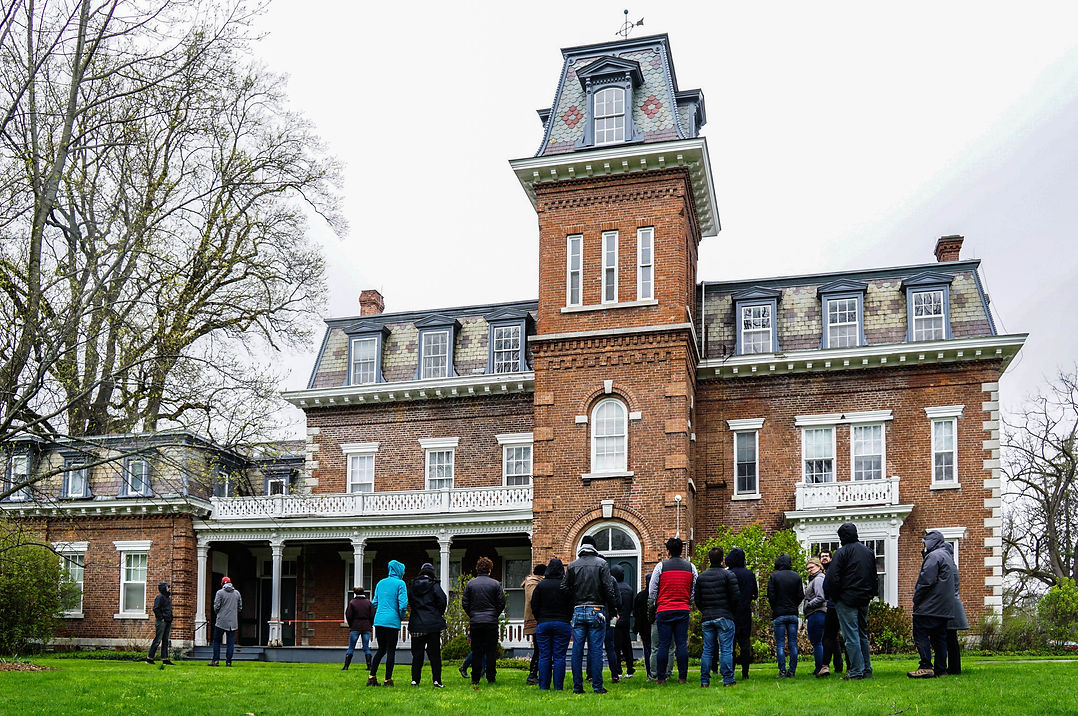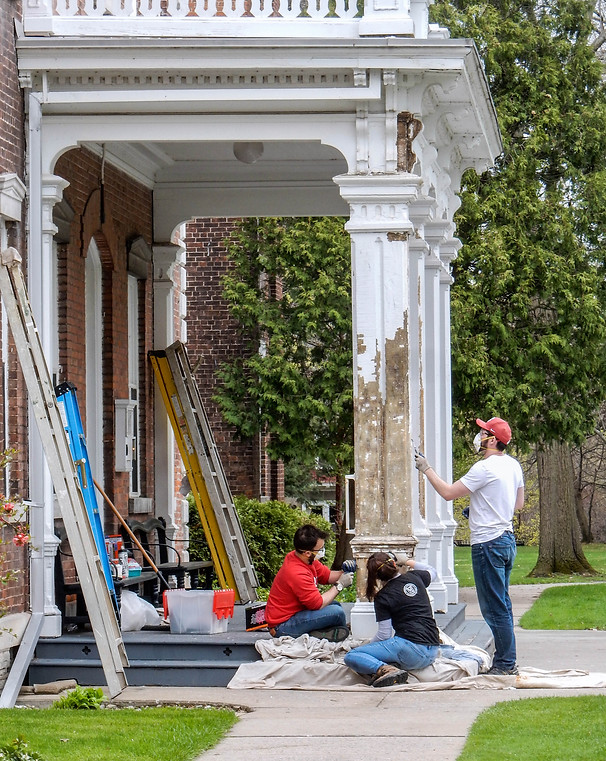
Cornell Comes to the Mansion House
On April 25, 2019, over 30 students and alums from Cornell University’s City & Regional Planning and Historic Preservation Planning departments arrived at the Mansion House for their annual Work Weekend. Their goal - to help preserve the Mansion House! As future planners and historic preservationists, these students were learning about the design and evolution of our built environment – the cities, buildings, and sites created by humans or shaped by human events.
Preservationists believe that these physical places and structures connect the past to the present and must be saved to preserve that connection. Rehabilitation and restoration can bring new life to cultural and historic sites, turning them into active resources for their community. The purpose of Cornell’s yearly Work Weekend is to contribute to local preservation efforts. The program offers professional advice and a large volunteer workforce to sites throughout the region, in exchange for training and hands-on experience for the students.
OCMH staff worked with students and faculty at Cornell for months to plan this weekend. Our project list was ambitious, but the weather conspired against us. Two of the originally planned projects had to be scrapped at the last minute because rain and sleet made outdoor painting and construction impossible. However, the students were undaunted and threw themselves into their work!
They scraped peeling paint off porches, replaced broken windowpanes, deconstructed rotted porch railings, meticulously documented their construction and condition, and painstakingly touched up years of damage to the building’s interior woodwork.
After two full days of hard work their achievements went above and beyond our staff’s wildest expectations. Click on the links below or scroll down to see photos from the weekend and learn about each project!

WINDOW
RESTORATION

The Mansion House has over 300 windows and doors. Because of their quantity and prominence in its facade (i.e. the “front face” of the building), they are considered one of our character defining features (architectural features that establish the general aesthetic of the building and without which, its character would be lost). Unfortunately, dozens of our windows have cracked panes of glass or some other form of damage. Our Building & Grounds staff works tirelessly on repairs and maintenance, but at a 93,000 sq. ft. site, our needs far outweigh our means.



Because of this, the students decided to help us out and execute some window repairs, under the expert guidance of window restoration artist Jerome Durr, who has been creating stained glass and restoring historic windows for decades. Before setting the students to work, he sat them down for a safety lecture and taught them a bit about what he does.


Once the training was over, the students set to work removing old putty, deinstalling broken panes, measuring the openings, tracing out the profiles of the panes and cutting and fitting new pieces of glass.

GRAIN PAINTING

The Mansion House has been continuously occupied for more than 150 years. It housed over 200 Oneida Community members for almost 20 years (1862-1881) and afterward continued to be a home for dozens of former members and their growing families. Later on, Oneida Ltd. employees, teachers, local professionals and newcomers to Sherrill began to fill its rooms as the city and company grew up around the Mansion House in the 20th century. Those years of use have taken their toll on the building and the wear and tear is strikingly evident on the moldings and paneling of its walls and doors.

When we first brainstormed projects for the students to take on, refinishing the interior woodwork seemed like a no brainer. It would be messy and labor-intensive, but we thought they could get a lot done and greatly improve the building’s appearance.
But as soon as we started examining the woodwork and doing a little historical research, we realized that we had to throw all our plans out the window - because the woodwork was painted, not stained!

GRAINING

GRAINING
Note the brush marks and parallel lines created using a comb and other tools. Layering these lines and colors can mimic the appearance of natural wood grain.

STAINED
We discovered that when the Mansion House was constructed, the Community decided to use cheaper lumber to make the doors, moldings, and wainscoting (“wall paneling”) and then paint it to look like more expensive hardwoods. This was a common practice in the 1800s, and the Community members did such a good job that modern visitors to the Mansion House usually don’t realize that they’re looking at a faux finish (material that’s been painted to look like something it’s not).
This discovery meant that we had to radically change our approach. Why? As a historic site, we want to preserve as many of our character defining features as possible, to maintain the historic integrity (authenticity) of the building. The interior woodwork helps define the aesthetic inside the Mansion House, and more importantly, since this finish was done by the Community members themselves, it is irreplaceable from a historical standpoint.

Our problem - how to preserve the woodwork, while repairing the damage? Our solution - “in-fills”!
This is exactly what it sounds like - filling in the areas of loss and damage. This seals the bare wood, giving it a layer of protection against water, dirt, dust, etc. But that’s the easy part. It is far more difficult to match the color and pattern of the original material, so that the viewer’s eye isn’t drawn to the areas of repair. Our Curator of Collections led this project, teaching the students how to color match, mix paints, and prepare the surface. The students were quick learners and by the end of Day 1 had completed repairs on the wall panels, doors, and moldings in our entry hall.


PAINTING PREP

Repainting was a big part of our plan for this weekend. There are eighteen porches on the Mansion House and all of them need to have their paint touched up every few years to help preserve the wood from rain, snow, sun and other causes of weathering or damage.
Unfortunately, after several sunny weeks, we were bombarded by rain and sleet throughout the weekend, which made painting impossible. Our staff thought we would have to scrap this whole project, but the students were determined to do as much as they could and decided to undertake the hardest part of repainting – prep work!


They spent hours scraping off peeling and flaking paint, being careful to remove any material no longer holding to the surface.
This ensures that the new layer of paint will bond to the wood, providing the maximum amount of protection against the elements.

PORCH
DEMOLITION

Our Buildings & Grounds staff spends hundreds of hours doing preventive maintenance on the Mansion House to keep it in good condition. But even so time, weather, and wear have caused extensive damage to some of our most vulnerable architectural features. Porches are highly susceptible to weather damage and on this south porch sections of the rails, balusters, and posts were rotted, and needed to be replaced.
To remove the rotted sections without damaging any sound material, we tasked the students with carefully removing the whole railing, so that it could be taken to our wood shop and disassembled.




The trim on the posts had to come off first, providing access to the connections between the posts and rails.

Once that was done, the students found that it was relatively easy to detach the rails and bring the whole thing down to the shop for the next phase of the restoration process.

MEASURED DRAWING


One of the projects we had to cancel was the restoration of one of our west porches. Because its location is highly exposed to the elements it has been severely damaged and become a safety hazard. Before the students arrived, OCMH’s Buildings & Grounds staff dismantled the porch to assess the condition of the different elements – deck, frame, railings, stairs, etc. – and order replacement materials.
The frame turned out to be in good condition, but the deck and stairs were badly rotted. We planned to have a small group work on reconstructing these parts. The decking had been replaced previously, so the material was non-historic. However, the railings date back to the late-1800s or early-1900s and are considered a historic feature. This meant that we had to preserve their design and as much of the original material as possible. But they were badly deteriorated. While some of the damage was cosmetic – peeling paint and rust stains from old nails – some sections of the baluster and posts were beyond repair.



So, the students decided to change jobs. Instead of tackling a more physically demanding construction project, they took on a more eye-straining challenge - creating measured drawings of our historic railings.



Measured drawings are documents that record the exact dimensions and design of an existing site, building, or feature. The examination and analysis involved in creating a measured drawing can reveal a lot about how and when something was built. It is also an important step in the restoration of these porch railings. Wherever the wood has deteriorated, the whole piece will have to be removed and new parts will be milled to replace them. The students measured everything and identified areas in need of repair and replacement. Once again, they spent hours doing the exacting and sometimes tedious prep work that is the necessary first step in the preservation process.


The profile of almost every flat sawn baluster in these railings is a slightly different shape and size. While the difference of a quarter inch is hardly noticeable to the human eye, it can make a huge difference when trying to fit a new piece into a historic frame.


Although the students didn’t get the experience they expected, they did get a crash course in some basic historic preservation skills – looking closely at things, measuring, and recording everything you see.



Altogether, the Cornell students put in hundreds of volunteer hours at the Mansion House, and in two days they were able to complete projects it would have taken our staff weeks, if not months to finish on their own. Working with them also helped us better understand the needs of our building and its unique features. We are incredibly grateful to them for the energy and enthusiasm they brought to our site.
OCMH would also like to express its grateful appreciation to the photographers who captured these images of the weekend and shared them with us. Photos in this exhibit were contributed by Jack Glassman, Pauline Caputi, Allison Turner, Kaitlin Piazza, and numerous other CRP and HPP students. Thank you all!
This work represents a fantastic step forward, but there’s still more to do! To learn more about current preservation projects at OCMH, visit our News page. And if you enjoyed this exhibit and are interested in supporting the work that we do, please consider volunteering, becoming a Member, or donating!










